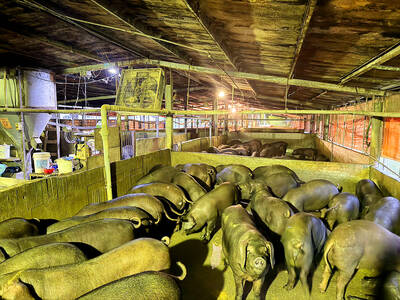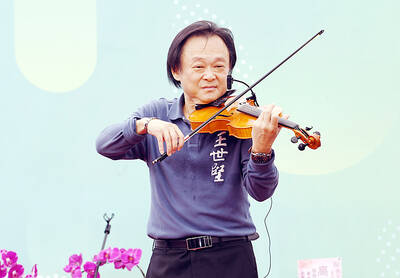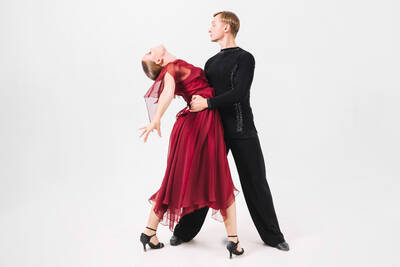歡迎閱讀《週末科學版》!我們每週五都要為你介紹可以在家中進行的有趣科學實驗。你可以在《科學日誌》中記錄自己做了哪些活動,這樣就可以將所學的記錄下來,比較這些結果,也許還可以利用它們來設計新的實驗!先看一下《科學日誌》的點子再開始吧。展開實驗之前,記得要獲得大人許可喔!
The first human-powered, heavier-than-air flight took place in North Carolina in 1903. The airplane was designed and built by the Wright brothers, after years of unsuccessful attempts.
Even though the Earth’s gravitational pull is very weak, it’s very difficult to escape it for very long. However, airplanes are somehow able to consistently cheat gravity. In today’s experiment we’re going to show you why airplanes can fly, using only a hairdryer and a ping-pong ball.

PHOTO: AFP
(JOHN PHILLIPS, STAFF WRITER)
世界第一架由人力發動、比空氣還重的飛機,一九O三年在美國北卡羅萊納州升空,萊特兄弟經過多年失敗的嘗試後,才設計打造了這架飛機。
雖然地心引力十分微弱,但要長時間�?牏O卻極為困難。然而,飛機因為某種原因卻能持續抵抗地心引力。今天的實驗中,我們將利用吹風機和一顆乒乓球來說明飛機的飛行原理。(翻譯:袁星塵)
METHODOLOGY 方法
Turn on the hairdryer and suspend a piece of tissue paper over it. You can identify the direction of the air stream by noticing which way the tissue blows.
Now carefully place the ping-pong ball into the air stream. The ball stays suspended above the hairdryer. Very carefully reach in and pull the ping-pong ball partially out of the air stream. You will notice that the air stream sucks the ball back into it.
With the ball still suspended on the air stream, hold the hairdryer close to a wall. Notice the height of the ball increases.
打開吹風機,把一張衛生紙懸放在其出風口。你可以藉由觀察衛生紙吹動的方向,辨認出氣流的方向。
接著,小心地把乒乓球放置在這股氣流上;乒乓球會飄浮於吹風機上方。非常小心地把手伸近這顆球,將它稍稍拉離氣流。你會發現,氣流會把乒乓球吸回去。
保持乒乓球懸浮在氣流之上,然後把吹風機靠近牆邊。注意觀察球的高度增加多少。
HOW IT WORKS 實驗原理
When the ball is suspended above the hairdryer, the high air pressure beats the Earth’s gravity and the ball floats. When you pull the ball partially out of the air stream, the air arcs round the curvature of the ball creating an area of low pressure. The normal air pressure on the other side of the ball is higher and therefore pushes the ball back in to the air steam.
The reason the pressure drops is based on a principle that states, “when air speeds up, its pressure drops.” When you walk closer to the wall, the air cannot expand anymore so it creates an area of even higher pressure under the ball, which forces the ball higher up.
當球懸浮在吹風機上方時,吹風機吹出的強大氣壓大過地心引力,使球懸浮在空中。當你將球部份拉離這道氣流時,乒乓球周圍循彎曲弧線行進的氣流會使該區氣壓降低。乒乓球另一邊的正常氣流氣壓較高,因此會將球推回原本的氣流。
乒乓球一邊的氣壓之所以會降低,是基於「氣流速度增加時,氣壓會降低」的科學原理。當你走近牆邊,空氣再也無法擴張,以致乒乓球下方形成一個氣壓更高的區域,這股力量迫使乒乓球浮得更高。
AERODYNAMICS 空氣動力學
We still haven’t really explained what allows airplanes to take off and remain in the air. The answer has to do with air pressure and aerodynamics. If you hold your hand out of a moving car window then tilt your hand upwards to force the air to flow down, you’ll notice that your hand seems to rise up.
This is exactly what airplane wings do. Last week we learnt about Newton’s third law, which states that for every action there is an equal an opposite reaction. An airplane wing forces air downwards. The opposite reaction is that the air forces the plane upwards. As long as the wings continue to force air downwards the plane will stay in the air.
我們還沒真正解釋飛機是怎麼飛上天且在空中巡航的;答案和氣壓及空氣動力學有關。如果你在行進中的車上把手伸出窗外,然後把手向上傾翻,迫使空氣向下流動。你會發現,你的手好像會浮升。
這就是飛機機翼的原理。上週我們學過牛頓第三定律,即每個作用力都會有一個等量且方向相反的反作用力。飛機的機翼迫使空氣向下,而反作用力就是迫使飛機上升的氣流,只要機翼持續迫使空氣向下,飛機就會維持在空中。

For many people in Taiwan, childhood memories of rural life include pig pens standing beside family homes. Leftover rice, vegetable scraps and soup from daily meals were poured into buckets and fed to pigs. This practice of feeding pigs with household food waste was once a common way of life, both an economic choice and an expression of agricultural society’s deep respect for conserving resources. From a practical standpoint, pigs are omnivorous animals capable of efficiently digesting food scraps that humans can no longer eat. For rural households, food waste cost almost nothing, yet it could be converted into pork, a

A: Apart from the world’s major dictionaries, the online Dictionary.com actually picked “67” as its word of the year. B: What does “67” even mean? A: Even the dictionary wasn’t exactly sure about its meaning. The slang term’s origin might be traced to US rapper Skrilla’s song Doot Doot (67). Aren’t Taiwanese media outlets choosing the Mandarin word for 2025? B: Yeah and after hearing the song Good-for-Nothing, adapted from some catchphrases of Legislator Wang Shih-chien, I’m going to vote for the character “tsung” (hasty) from the lyrics. A: Hopefully, in the new year, we’ll be calm as the

Sea star wasting disease (SSWD) is a strange and serious illness affecting sea stars, or starfish. This disease causes sea stars to develop painful lesions, lose their arms, and eventually turn into a gooey, melted mess. Since it was first observed in 2013, millions of sea stars along the Pacific coast of North America have died from this __1__. Although viruses were once considered a possible cause, researchers now believe that environmental stressors and microorganisms are primarily __2__ for sea star wasting disease. One of the main environmental triggers appears to be warmer ocean water. When the water heats

Tango unfolds in a dimly lit room, where a haunting melody ushers two dancers into a close embrace. Here, music and movement merge into a silent yet passionate conversation, expressing longing, memory and shared purpose. What makes tango truly magical is the deep interaction and spontaneous improvisation between partners. Tango began in the late 19th century in Buenos Aires, Argentina’s bustling capital. Born in the poor working-class neighborhoods and busy port areas, this dance emerged from a melting pot of cultures. European immigrants, African slaves and local residents all contributed to its unique character. From these rich influences, tango